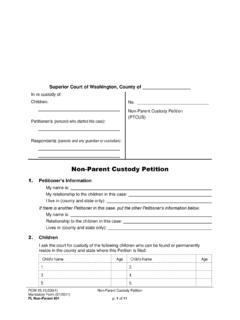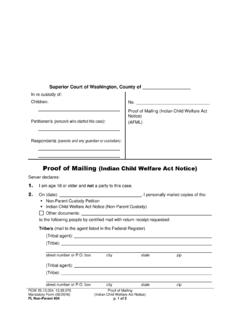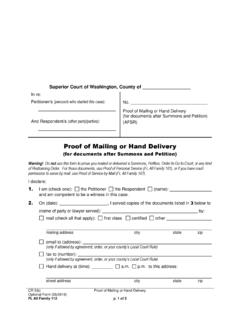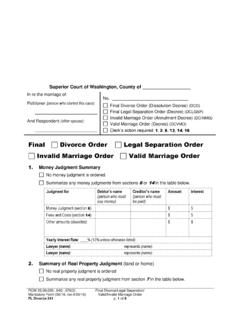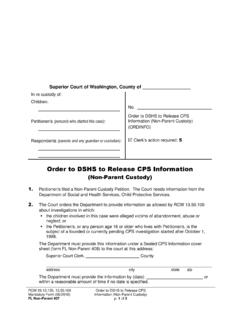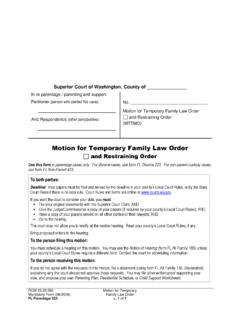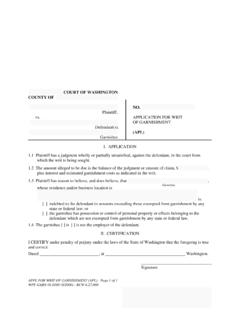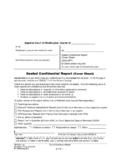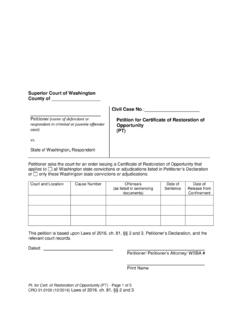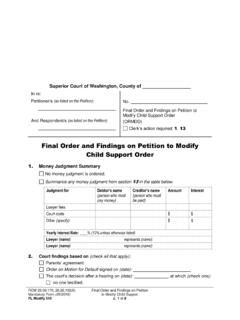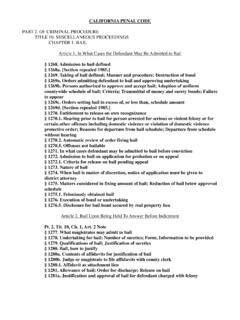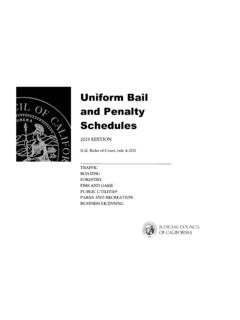Transcription of CrR 3.2 RELEASE OF ACCUSED (a) Presumption of Release in ...
1 CrR RELEASE OF ACCUSED If the court does not find, or a court has not previously found, probable cause, the ACCUSED shall be released without conditions. (a) Presumption of RELEASE in Noncapital Cases. Any person, other than a person charged with a capital offense, shall at the preliminary appearance or reappearance pursuant to rule or CrRLJ be ordered released on the ACCUSED 's personal recognizance pending trial unless: (1) the court determines that such recognizance will not reasonably assure the ACCUSED 's appearance, when required, or (2) there is shown a likely danger that the ACCUSED : (a) will commit a violent crime, or (b) will seek to intimidate witnesses, or otherwise unlawfully interfere with the administration of justice. For the purpose of this rule, "violent crimes" are not limited to crimes defined as violent offenses in RCW In making the determination herein, the court shall, on the available information, consider the relevant facts including, but not limited to, those in subsections (c) and (e) of this rule.
2 (b) Showing of Likely Failure to Appear Least Restrictive Conditions of RELEASE . If the court determines that the ACCUSED is not likely to appear if released on personal recognizance, the court shall impose the least restrictive of the following conditions that will reasonably assure that the ACCUSED will be present for later hearings, or, if no single condition gives that assurance, any combination of the following conditions: (1) Place the ACCUSED in the custody of a designated person or organization agreeing to supervise the ACCUSED ; (2) Place restrictions on the travel, association, or place of abode of the ACCUSED during the period of RELEASE ; (3) Require the execution of an unsecured bond in a specified amount; (4) Require the execution of a bond in a specified amount and the deposit in the registry of the court in cash or other security as directed, of a sum not to exceed 10 percent of the amount of the bond, such deposit to be returned upon the performance of the conditions of RELEASE or forfeited for violation of any condition of RELEASE .
3 If this requirement is imposed, the court must also authorize a surety bond under section (b)(5); (5) Require the execution of a bond with sufficient solvent sureties, or the deposit of cash in lieu thereof; (6) Require the ACCUSED to return to custody during specified hours or to be placed on electronic monitoring, if available; or (7) Impose any condition other than detention deemed reasonably necessary to assure appearance as required. If the court determines that the ACCUSED must post a secured or unsecured bond, the court shall consider, on the available information, the ACCUSED s financial resources for the purposes of setting a bond that will reasonably assure the ACCUSED s appearance. (c) Relevant Factors Future Appearance. In determining which conditions of RELEASE will reasonably assure the ACCUSED 's appearance, the court shall, on the available information, consider the relevant facts including but not limited to: (1) The ACCUSED 's history of response to legal process, particularly court orders to personally appear; (2) The ACCUSED 's employment status and history, enrollment in an educational institution or training program, participation in a counseling or treatment program, performance of volunteer work in the community, participation in school or cultural activities or receipt of financial assistance from the government; (3) The ACCUSED 's family ties and relationships; (4) The ACCUSED 's reputation, character and mental condition; (5) The length of the ACCUSED 's residence in the community.
4 (6) The ACCUSED 's criminal record; (7) The willingness of responsible members of the community to vouch for the ACCUSED 's reliability and assist the ACCUSED in complying with conditions of RELEASE ; (8) The nature of the charge, if relevant to the risk of nonappearance; (9) Any other factors indicating the ACCUSED 's ties to the community. (d) Showing of Substantial Danger Conditions of RELEASE . Upon a showing that there exists a substantial danger that the ACCUSED will commit a violent crime or that the ACCUSED will seek to intimidate witnesses, or otherwise unlawfully interfere with the administration of justice, the court may impose one or more of the following nonexclusive conditions: (1) Prohibit the ACCUSED from approaching or communicating in any manner with particular persons or classes of persons; (2) Prohibit the ACCUSED from going to certain geographical areas or premises; (3) Prohibit the ACCUSED from possessing any dangerous weapons or firearms, or engaging in certain described activities or possessing or consuming any intoxicating liquors or drugs not prescribed to the ACCUSED .
5 (4) Require the ACCUSED to report regularly to and remain under the supervision of an officer of the court or other person or agency; (5) Prohibit the ACCUSED from committing any violations of criminal law; (6) Require the ACCUSED to post a secured or unsecured bond or deposit cash in lieu thereof, conditioned on compliance with all conditions of RELEASE . This condition may be imposed only if no less restrictive condition or combination of conditions would reasonably assure the safety of the community. If the court determines under this section that the ACCUSED must post a secured or unsecured bond, the court shall consider, on the available information, the ACCUSED s financial resources for the purposes of setting a bond that will reasonably assure the safety of the community and prevent the defendant from intimidating witnesses or otherwise unlawfully interfering with the administration of justice; (7) Place the ACCUSED in the custody of a designated person or organization agreeing to supervise the ACCUSED ; (8) Place restrictions on the travel, association, or place of abode of the ACCUSED during the period of RELEASE ; (9) Require the ACCUSED to return to custody during specified hours or to be placed on electronic monitoring, if available.
6 Or (10) Impose any condition other than detention to assure noninterference with the administration of justice and reduce danger to others or the community. (e) Relevant Factors Showing of Substantial Danger. In determining which conditions of RELEASE will reasonably assure the ACCUSED s noninterference with the administration of justice, and reduce danger to others or the community, the court shall, on the available information, consider the relevant facts including but not limited to: (1) The ACCUSED s criminal record; (2) The willingness of responsible members of the community to vouch for the ACCUSED s reliability and assist the ACCUSED in complying with conditions of RELEASE ; (3) The nature of the charge; (4) The ACCUSED s reputation, character and mental condition; (5) The ACCUSED s past record of threats to victims or witnesses or interference with witnesses or the administration of justice; (6) Whether or not there is evidence of present threats or intimidation directed to witnesses.
7 (7) The ACCUSED s past record of committing offenses while on pretrial RELEASE , probation or parole; and (8) The ACCUSED s past record of use of or threatened use of deadly weapons or firearms, especially to victims or witnesses. (f) Delay of RELEASE . The court may delay RELEASE of a person in the following circumstances: (1) If the person is intoxicated and RELEASE will jeopardize the person s safety or that of others, the court may delay RELEASE of the person or have the person transferred to the custody and care of a treatment center. (2) If the person s mental condition is such that the court believes the person should be interviewed by a mental health professional for possible commitment to a mental treatment facility pursuant to RCW , the court may delay RELEASE of the person. (3) Unless other grounds exist for continued detention, a person detained pursuant to this section must be released from detention not later than 24 hours after the preliminary appearance.
8 (g) RELEASE in Capital Cases. Any person charged with a capital offense shall not be released in accordance with this rule unless the court finds that RELEASE on conditions will reasonably assure that the ACCUSED will appear for later hearings, will not significantly interfere with the administration of justice and will not pose a substantial danger to another or the community. If a risk of flight, interference or danger is believed to exist, the person may be ordered detained without bail . (h) RELEASE After Finding or Plea of Guilty. After a person has been found or pleaded guilty, and subject to RCW , , , and , the court may revoke, modify, or suspend the terms of RELEASE and/or bail previously ordered. (i) Order for RELEASE . A court authorizing the RELEASE of the ACCUSED under this rule shall issue an appropriate order containing a statement of the conditions imposed, if any, shall inform the ACCUSED of the penalties applicable to violations of the conditions imposed, if any, shall inform the ACCUSED of the penalties applicable to violations of the conditions of the ACCUSED 's RELEASE and shall advise the ACCUSED that a warrant for the ACCUSED 's arrest may be issued upon any such violation.
9 (j) Review of Conditions. (1) At any time after the preliminary appearance, an ACCUSED who is being detained due to failure to post bail may move for reconsideration of bail . In connection with this motion, both parties may present information by proffer or otherwise. If deemed necessary for a fair determination of the issue, the court may direct the taking of additional testimony. (2) A hearing on the motion shall be held within a reasonable time. An electronic or stenographic record of the hearing shall be made. Following the hearing, the court shall promptly enter an order setting out the conditions of RELEASE in accordance with section (i). If a bail requirement is imposed or maintained, the court shall set out its reasons on the record or in writing. (k) Amendment or Revocation of Order. (1) The court ordering the RELEASE of an ACCUSED on any condition specified in this rule may at any time on change of circumstances, new information or showing of good cause amend its order to impose additional or different conditions for RELEASE .
10 (2) Upon a showing that the ACCUSED has willfully violated a condition of RELEASE , the court may revoke RELEASE and may order forfeiture of any bond. Before entering an order revoking RELEASE or forfeiting bail , the court shall hold a hearing in accordance with section (j). RELEASE may be revoked only if the violation is proved by clear and convincing evidence. (l) Arrest for Violation of Conditions. (1) Arrest With Warrant. Upon the court's own motion or a verified application by the prosecuting attorney alleging with specificity that an ACCUSED has willfully violated a condition of the ACCUSED 's RELEASE , a court shall order the ACCUSED to appear for immediate hearing or issue a warrant directing the arrest of the ACCUSED for immediate hearing for reconsideration of conditions of RELEASE pursuant to section (k).
